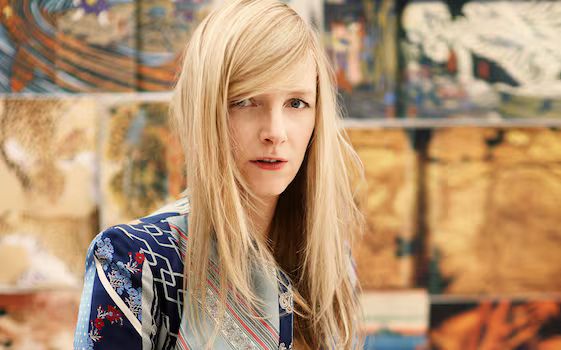Her first collection leaned into this rediscovery—not by replication, but through reinterpretation. A mesh bodysuit stamped with “Givenchy Paris 1952” opened the show: a signpost. A nod. Burton didn’t want to copy Hubert de Givenchy; she wanted to understand his genesis, his atelier, his proportions—and then walk forward with that foundation under her feet.
⸻
II. Quiet Power and Crafted Duality
One of the most compelling things Burton did was strike a balance: she embraced dualities—hard and soft, structure and transparency, past and future.
•Tailoring, always her forte from her McQueen years, was present in sculpted coats, broad shoulders, nipped waists, and sharply defined trousers.
•Sheer elements and mesh both revealed and suggested, while drapes or finishing of linings showed craftsmanship.
•Colour palette was largely monochromatic—grays, blacks, whites—with flashes of pastel yellow and candy pink, small shocks of colour that felt hopeful, not garish.
This duality offers something for different people: for those who demand power and presence, there’s structure. For those who want vulnerability and comfort, there’s flowing fabric, softness. It said: you can hold strength without sacrificing elegance—or your own sense of self.
⸻
III. Back to the Atelier: Craft, Pattern, Intimacy
Burton’s words give away what it is she values: “To go forward, you have to go back to the beginning. To me, that’s about the atelier. It’s the heart and soul of Givenchy.”
Her process showed it. She built some pieces on models, with careful attention to proportion, shape. She leaned into pattern-cutting, the tactile things—how fabric falls, how seams turn, how backs can be as expressive as fronts.
In an age where fashion sometimes favors hype over substance, Burton’s debut leaned into what many appreciate but few always see: the disciplines of tailoring, fitting, silhouette. For someone buying clothes for work, for events, even just dinner—it suggests garments built to last not just in style but texture and experience.
⸻
IV. Symbolism in Details: LBD, Make-Up Cases, and Visage
Burton sprinkled symbolism throughout. Some of it subtle, some playful:
•She re-entered the little black dress, an iconic Givenchy staple, but varied it: sheer, short with trains, accenting curves, revealing the back, exposing linings. A conversation with history—but a personal one.
•One standout piece was a dress made of discarded makeup cases and compacts—beauty accessories reworked into couture. It felt less like gimmick, more like metaphor: what women use to define themselves, the rituals around self-image, turned into art.
•Styling details—oversized gem earrings, visors, ballet pumps versus patent vinyl boots—helped show versatility. Soft and hard, day and night.
These touches make the runway feel less distant. They nod toward everyday objects, embedding fashion in recognizable rituals of beauty, dressing, identity. They say: style isn’t just spectacle—it’s what you wear when you want to feel seen, when you step out of your door.
⸻
V. What It Means for Everyday People
What does something like this—Burton’s debut—mean for you or me? More than you might immediately think.
1.Expect more versatility in high fashion trickling down
When a luxury house like Givenchy gives such weight to both drama and wearability, that attitude tends to percolate. Ready-to-wear, even in more “accessible” tiers, will likely emphasize garments that make statements but can be integrated into ordinary lives.
2.Greater respect for craftsmanship
As conversations around sustainability, durability, ethics grow louder, the public becomes more attuned to how clothes are made, how they last. Burton’s focus on atelier methods reminds us that there’s value in things made with craft—and that paying more for quality can make sense.
3.Fashion as identity, not just trend
Burton asks: Who do you want to be when you wear clothes? Do you want to be powerful? Soft? Sensual? Protected? Seen? Her collection gives permission to carry multiple selves. For everyday wearers, that means clothing choices may shift from “what’s hot right now” to “what expresses me.”
4.Bridging heritage and renewal
Many of us live with histories—family, cultural, stylistic. Burton’s work suggests fashion can honor our origins while helping us transform. It means fashion needn’t force you to choose between the old and the new; it can help you carry both.
⸻
VI. Risks, Expectations, and What Comes Next
No debut is perfect, and Burton’s has its challenges. The fashion world is watching:
•Commercial viability: high craftsmanship often means higher costs. Will Givenchy under Burton translate this heritage-inflected luxury into pieces people can wear, want, and afford (within its market) consistently?
•Balancing identity: she must tread carefully between honoring Givenchy’s legacy and avoiding a museum version of the past. Too much tribute risks being safely predictable; too much innovation risks alienating heritage loyalists.
•Cultural resonance: in a world that’s increasingly global, fashion needs both specificity and universality. How will Burton’s vision at Givenchy connect across markets with different tastes, climates, styles?
⸻
VII. Conclusion: A New Chapter, Not a Rewrite
Sarah Burton’s first Givenchy collection doesn’t feel like a takeover. It doesn’t shout “reset everything.” It feels more like someone taking what is beloved, what is foundational, dusting it off, polishing its edges, and asking: what if we lived with this in the 2020s?
She has begun telling a story that is attentive: to history, to craft, to femininity that encompasses many notes—power and fragility, tradition and risk, softness and bite.
For those of us who choose clothes every day, care about how we present ourselves, how garments shape us as much as we shape them—this matters. It suggests fashion is still capable of poetry: of sending signals, of creating reflection, of helping us walk into ourselves with some piece of confidence.
Givenchy under Sarah Burton may be new, but it already feels grounded. The runway door opened, and instead of being blinded by flash, we saw detail. Instead of being overwhelmed by spectacle, we felt possibility.

